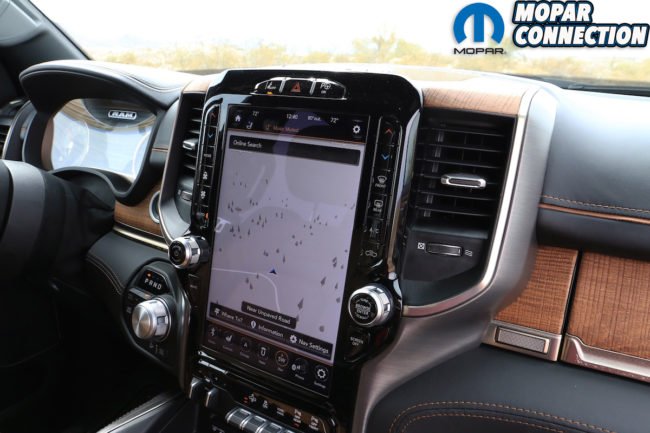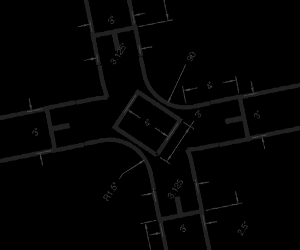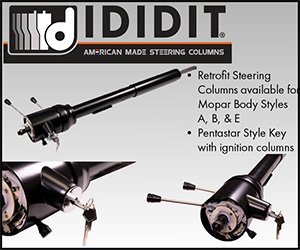
Things are looking pretty rosy for FCA’s truck brand right now – the outgoing 1500 is coming off a best-ever February for the company, and annual sales are at an all-time high. But with Ford’s F-150 still maintaining a stranglehold on the top spot in the segment, Ram doesn’t have the luxury of resting on their laurels.
“Since we started as a standalone brand in 2009, we’ve had a laser focus on the truck customer,” explained Jim Morrison, head of Ram Trucks North America. “And this new 1500 is the most significant accomplishment we’ve had so far.”
Earlier this month we found ourselves in a dimly-lit converted barn outside of Scottsdale, Arizona, flanked by various iterations of Ram’s all-new full-sized light duty pickup. With the barn’s dirt floor juxtaposed by the upscale lighting arrangements and expensive electronics, the venue served as something of a metaphor for the truck itself.

“We’re changing the way the world is looking at strength, durability, and technology,” Morrison added. And while it’s easy to dismiss that as marketing speak, the new truck’s spec sheet looks to be backing up Jim’s claim: A new stronger, lighter and more rigid frame, big increases in payload and towing, a new available “eTorque” mild hybrid system, best-in-class aerodynamics, 360-degree cameras, a new tablet-sized Uconnect touchscreen infotainment system – the list goes on.
But as we’ve learned time and again, the spec sheet doesn’t always tell the whole story. To get a better understanding of what Ram has done with this all-new, fifth generation 1500 pickup, we headed out on Arizona’s streets, highways, and off-road trails to put the company’s new machine through its paces. Here’s what we discovered.
Latest and Greatest
Launching with half a dozen trim levels to choose from – Tradesman, Bighorn, Rebel, Laramie, Laramie Longhorn and Limited – part of Ram’s mission with the new 1500 was to ensure they were leaving any potential sales on the table by ignoring a portion of the market.
That means that the bones underpinning the upscale, luxury-focused Limited model are present in the far more utilitarian Tradesman, and while the two trucks have entirely different missions, it only serves to illustrate the fact that many of the enhancements that Ram has brought to the table with the new 1500 go right down to the core of the truck’s design.
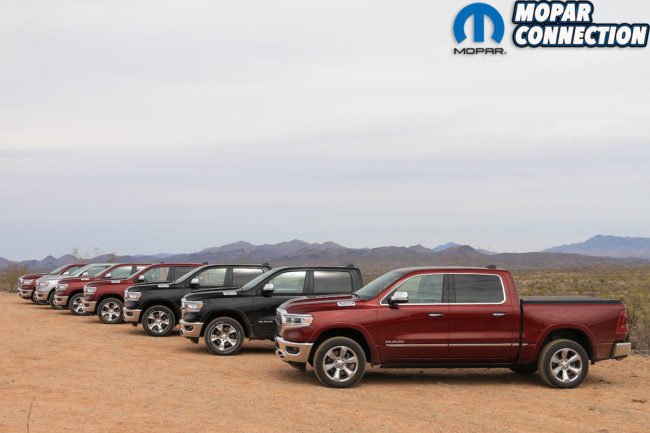
“This is a non-compromised truck,” said Rob Wichman, head of engineering for Ram. “We’ve raised the bar on durability, efficiently, and technology. We’ve increased the capability of this truck – it now delivers 2300 pounds of payload and 12,750 pounds of trailer towing capability. We’ve improved the ride, the handling, the braking – the overall vehicle dynamics. We’ve also improved our efficiencies too, with changes like 225 pounds of weight reduction and improvements in aerodynamics.”
The 1500’s weight reduction starts at the frame, a new design that’s both lighter and more rigid than the outgoing model. It’s strong enough that Ram saw fit to now offer the off-road focused Rebel model in Crew Cab configuration – previously the Rebel was only available in Quad Cab configuration – yet aluminum is also used in strategic areas like the transmission crossmember to keep the pounds down. Aluminum is also used for the hood and tailgate, while the redesigned box accounts for nearly 100 pounds of the weight savings alone, employing the use of hydroformed high-strength steel for more than 50% of its construction.
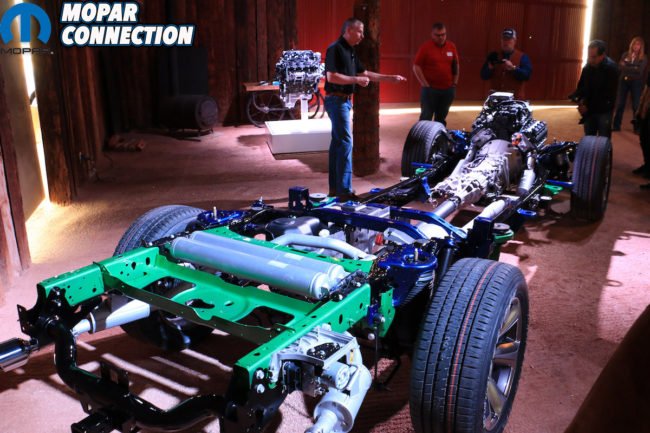
The chassis sees its fair share of attention as well, with improved handling and steering feel by way of new, lightweight composite upper control arms, aluminum lower control arms and retuned suspension geometry, while out back a third-generation five-link setup is on hand. New Frequency Response Damping (FRD) shocks are installed at all four corners as standard and are designed to provide more responsive handling during cornering and heavy braking by closing the bypass valve during such maneuvers, then opening it back up for better ride quality at higher speeds.
Under the hood Ram offers the 3.6-liter, 305 horsepower V6 and 5.7-liter, 395 horsepower Hemi V8 that we’re all familiar with by now, but here they’re both sporting new party trick – a mild hybrid system. Dubbed eTorque, this optional 48-volt system is designed to work in conjunction with the start/stop system to provide a more seamless transition off the line, improving the truck’s efficiency without leaving the pickup dead at a stop light until the gas motor fires back up.

The eight-speed TorqueFlight automatic transmission is now standard across the model lineup, while a BorgWarner 48-12 transfer case is utilized for part-time 4WD operation with Hi and Low ranges, while the BorgWarner 48-11 is equipped for on-demand 4WD on models optioned with that capability. Both transfer cases are operated by way of push-button controls located underneath the gear selector on the instrument panel.
OK – all that engineering stuff is swell, but what’s it like to look at and sit in?

Inside and Out
“We wanted to move away from the crosshair grille, but retain the 1500’s big rig-inspired look,” said Joe Dehner, chief exterior designer for Ram. “We did a lot of work in the wind tunnel with this truck to get the aero numbers to world-class levels, but we didn’t want to lose sight of the 1500’s style in the process.”
While the tweaks to the exterior feel more like evolution than revolution, there are some changes worth noting. No less than 15 new wheel styles are on tap here, and that’s partially out of necessity since the 2019 Ram 1500 brings with it a new six-lug wheel hub as part of its strengthening regimen. There’s also a new ram’s head badge on the tail gate, while Rebel models stick with that big RAM stamp.
Many of the other exterior revisions focus on adding technology without it looking like an afterthought – the 360-degree camera system, for instance, utilizes cameras that have been integrated into the design of the fog light bezels, tailgate, and side mirrors, while the deployable step assist designed into the rear bumper is more or less unnoticeable when not in use.
That theme of accentuating aesthetic strengths without reinventing the design continues in the cabin as well, where Ram has gone to great lengths to give the interiors of different trim levels their own personality that jives with the exterior treatments without completely reworking the layout. “You really need to have something that’s tailored for every buyer,” said Ryan Nagode, chief interior designer for Ram. “For us, it was about designing the best interior for any truck in the market, with an emphasis on emphasis on storage, function and technology.”

On that first point, the center console and the washable storage bins underneath the front seats each offer 40 liters of cargo volume. The center storage up front feels particularly cavernous, offering not only lots of space but a multitude of integrated holders for change, cups, sunglasses, phones, and other knick-knacks, along with an all-new optional integrated wireless charging pad that can support a tablet or several phones.
No less than five USB ports are equipped throughout the truck – three up front and two in the rear – and we were surprised to discover USB-C ports installed alongside the now-old school traditional USB ports, quite possibly a first for the truck segment on the whole.
While the presence of USB-C in a pickup truck is a pleasant surprise, when it comes to the new 1500’s technological suite, it’s the new 12-inch touchscreen display that steals the show. The screen real estate it offers is simply immense, and it somehow makes the 8.4-inch Uconnect system feel low rent by comparison. While the entire display can be utilized for functions like GPS navigation, it can also be customized to display two different features simultaneously – for instance, you can have your media controls and information on the top half, while the bottom half offers up the HVAC controls or another function of your choosing.
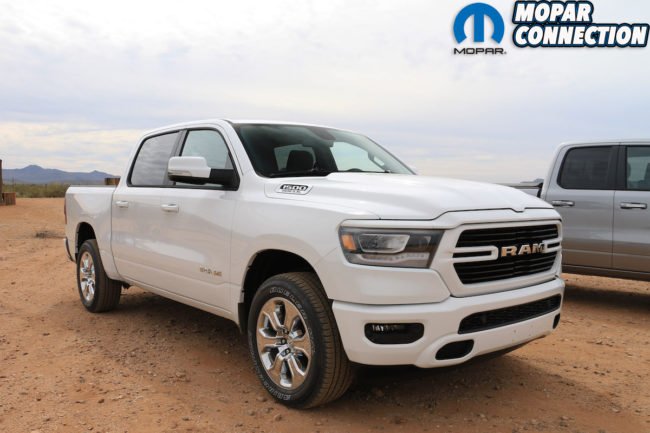
On The Road
We started the day in a highly-optioned Laramine Longhorn with the 4×4 Off-Road Package. Described by Nagode as the “alter-ego to the Limited model” due to its upscale appointments, the Longhorn has a more blue collar vibe overall, exemplified by touches like the logo on the wood dashboard that is applied with an actual branding iron. Don’t misperceive the Longhorn as a farm truck though – this is still undoubtedly about luxury, and the quiet, feature-packed cabin would still rival plenty of European sedans for both comfort and material quality, although we’d expect fewer gold accents in the latter.
While the 5.7-liter V8 and the eight-speed automatic have been available in the 1500 for a while now, the retuned exhaust gives the new Mopar pickup a proper Hemi roar that’s now closer in line with the active exhaust systems found on the performance-oriented trim levels of the Dodge Challenger and Charger. The quick ratios of the eight-speed’s lower gears allowed this loaded Quad Cab 1500 to get off the line with plenty of haste when we, uh, tested that retuned exhaust system out, though it’s worth noting that Ford’s 3.5-liter twin-turbocharged EcoBoost mill feels a bit more urgent in the mid-range. It’s a concession we’d happily make for the sake of that Hemi engine note, though.
Our tester was also outfitted with the optional air suspension system, which replaces the traditional coil springs with pressurized gas. This not only improves ride quality, it also allows the driver to adjust the truck’s ride height on the fly – dropping the stance will provide better fuel economy on the highway, Ram says, and make it easier to load and unload cargo. At speed the handling differences between the different ride heights is indiscernible, but the convenience of the system’s automatic load leveling and height adjustment seem well worth the added expense of $1795.
One of the other boxes checked on this Longhorn was the aptly-named 4×4 Off-road Package. Here that equates to a one-inch higher ride height, off-road-biased rear suspension geometry, specially tuned Bilstein shocks with remote reservoirs in the rear for improved heat management, an electronic-locking rear differential, underbody skid plates that provide protection for the transfer case, steering system, oil pan and gas tank, Hill-descent Control, and 32-inch Falken all-terrain tires.
Though it’s unlikely that a $60,000+ pickup like this well-optioned Longhorn will see much time on the trails, we felt compelled to make sure it could hold its own – high-speed jaunts over rutted dirt routes left the Longhorn unfazed, with the four-wheel drive system providing seamless stability while the beefed-up suspension system dispatched the uneven terrain with minimal body motions.





